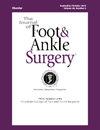Defining the patient acceptable symptom state (PASS) for PROMIS after Hallux Rigidus correction surgery
IF 1.3
4区 医学
Q2 Medicine
引用次数: 0
Abstract
It is unclear which patient reported outcome metric correlates best with clinical improvement. The patient acceptable symptom state (PASS) incorporates the patient's subjective outcome experience into the outcome measurement. This study aims to establish PASS thresholds using Patient-Reported Outcome Measurement Information System (PROMIS) scores in patients undergoing hallux rigidus (HR) correction. A retrospective review of prospectively collected data identified 144 patients who were treated surgically for HR between February 2019 and March 2021, had preoperative and 2-year postoperative PROMIS scores, and had responses to two distinct PASS anchor questions. PASS thresholds were determined using the maximum Youden Index. Differences in demographic and surgical characteristics between patients who met or did not meet the PASS thresholds were compared using independent samples T-tests and Pearson Chi-Square tests. Overall, 70 % of patients met the PASS thresholds. Patients with better baseline PROMIS scores were more likely to meet the postoperative PASS thresholds for every PROMIS domain (p < 0.05). Patients who did not undergo first metatarsophalangeal (MTP) fusion were more likely to reach the PASS threshold for the Physical Function domain (p = 0.045). For the Pain Intensity domain, younger patients were more likely to meet the thresholds (p = 0.005). Patient sex, BMI, and use of either cheilectomy or Akin/Moberg osteotomy during surgery did not impact a patient's likelihood of meeting the PASS thresholds. After surgical intervention for HR, it may not be necessary for patients to reach normal physical function or pain levels in order to reach an acceptable postoperative symptom state.
确定拇僵直矫正手术后患者可接受症状状态(PASS)。
目前尚不清楚哪个患者报告的结果指标与临床改善最相关。患者可接受症状状态(PASS)将患者的主观结果体验纳入结果测量。本研究旨在利用患者报告的结果测量信息系统(PROMIS)评分来建立拇僵直(HR)矫正患者的PASS阈值。对前瞻性收集的数据进行回顾性分析,确定了144名在2019年2月至2021年3月期间接受手术治疗的HR患者,他们有术前和术后2年的PROMIS评分,并对两个不同的PASS锚定问题有反应。通过阈值采用最大约登指数确定。采用独立样本t检验和皮尔逊卡方检验比较满足或不满足PASS阈值的患者的人口学和手术特征的差异。总体而言,70%的患者达到了PASS阈值。基线PROMIS评分较好的患者更有可能达到术后每个PROMIS域的PASS阈值(p < 0.05)。未接受第一跖趾(MTP)融合的患者更有可能达到物理功能域的PASS阈值(p = 0.045)。对于疼痛强度域,年轻患者更有可能达到阈值(p = 0.005)。患者的性别、BMI以及手术中是否进行了颧骨切除术或Akin/Moberg截骨术均不影响患者达到PASS阈值的可能性。HR手术干预后,患者可能不需要达到正常的身体功能或疼痛水平,即可达到可接受的术后症状状态。证据等级:III级,回顾性审查。
本文章由计算机程序翻译,如有差异,请以英文原文为准。
求助全文
约1分钟内获得全文
求助全文
来源期刊

Journal of Foot & Ankle Surgery
ORTHOPEDICS-SURGERY
CiteScore
2.30
自引率
7.70%
发文量
234
审稿时长
29.8 weeks
期刊介绍:
The Journal of Foot & Ankle Surgery is the leading source for original, clinically-focused articles on the surgical and medical management of the foot and ankle. Each bi-monthly, peer-reviewed issue addresses relevant topics to the profession, such as: adult reconstruction of the forefoot; adult reconstruction of the hindfoot and ankle; diabetes; medicine/rheumatology; pediatrics; research; sports medicine; trauma; and tumors.
 求助内容:
求助内容: 应助结果提醒方式:
应助结果提醒方式:


